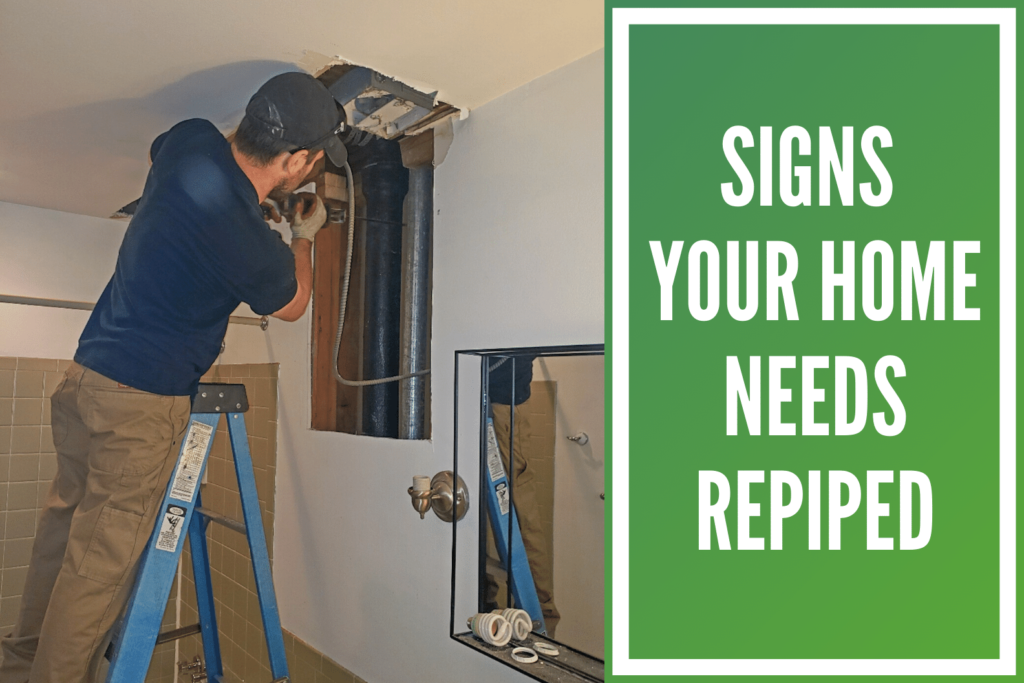When it comes to managing a home’s plumbing system, there’s a fine line between repairs and replacements. Sometimes a simple repair or pipe change will do the trick, while other times it will require completely gutting everything! Without a doubt though, repiping is something that falls under the category that could go either way.
For those new to our blog, welcome to Stine-Nichols Plumbing! We are a full-service residential and commercial plumbing business located in Kansas City. Residential service calls, commercial design build projects, you name it and we do it! Today, we’re going to focus primarily on repiping. While it’s impossible to predict the exact time in which you’d need to replace your pipes, there’s no denying the fact that they’ll eventually need repiped. At the same time, it should also come as no surprise that repiping an entire home is quite the project and can require a significant investment!
With that in mind, here are just a few of the most common signs that may signal a repiping project is coming up! Before making any major decisions though, make sure to call your local plumber and have them take a look! They’ll be able to determine whether you’re looking at something minor or major!
Old Pipes
No matter how good of a plumber you have, all pipes are eventually going to fail and need replaced. Yes, being careful with what you put through the drains can prolong the lifespan of your pipes, but replacing is an inevitable reality of old pipes. Here’s a few things to look out for:
- Noisy Pipes – Any time you hear any clunking or rattling within your pipes, this is an immediate red flag. However, it doesn’t always spell disaster, as it could just mean something is loose and causing these noises!
- Unsafe Materials – We actually covered the topic of unsafe piping materials in-depth on a recent blog post. To recap, the main message was that there’s a certain number of years you can expect to get out of any given plumbing pipe. Copper, brass, cast iron, PVC, you name it! However, there’s also a few materials widely used a while back that are no longer recommended. For example, lead pipes have since been banned due to the health risks they pose. In addition, polybutylene was heavily used in the 80’s and 90’s, and has since found its way to the center of many lawsuits! If your home has either of these, we strongly recommend getting them swapped out ASAP!
Discolored Water
Another obvious sign of a piping issue would be any water discoloration. If water ever comes out of a faucet looking brownish or reddish, chances are there’s some sediment or rust built up somewhere in your pipes. While a complete repiping may not be necessary, this definitely is something you’d want a licensed plumber to get eyes on.
As a side note, be sure to check this for both hot and cold water. If the issue resides solely with hot water, the issue may be more centralized on the hot water heater itself. For those that haven’t flushed their water heater in awhile, sediment can build up at the bottom of the tank and gradually cause rust!
Smell or Taste of Water
Next on our list is yet another clear sign that something is up! Anytime your water tastes weird or even just has a funky smell, this could very well mean there’s an internal issue with your pipes. If you’re dealing with this, have a plumber take a look immediately. This is a perfect example of a problem that could cause health risks if not dealt with in a timely fashion.
Water Pressure Issues
Any instances of low water pressure is an instant giveaway that something isn’t right. With this, remember that there are plenty of cases where we just need to repipe a single feature, such as a toilet or tub. Chances are this could easily fall under that label. Nonetheless, whenever you notice low water pressure (whether that be the sink, shower or anywhere else), repiping could easily be the solution. A licensed plumber will be able to tell the difference between a piping issue and a fixture one.
Unpredictable Water Temperature Changes
Ever been taking a shower and all of a sudden out of nowhere, you feel a sudden jolt of cold water? I’m guessing this certainly caught you by surprise and had you wondering how that could even happen in the first place. Well, whenever the water temperature is difficult to adjust, this could be signaling that your pipes need replaced!
What’s the Process for Repiping an Entire Home?
Before we dive into all of the numbers in the section below this, it’s not uncommon to wonder what all a repiping project entails. After all, aren’t the majority of your pipes hidden behind walls and not easily accessible? That is correct! And that is also part of the reason why complete repiping projects tend to be one of the more expensive plumbing projects someone may face as a homeowner.
Without getting too much construction lingo going, we’ll quickly walk you through what repiping entails. As a side note, remember that repiping doesn’t always entail replacing absolutely everything. Sometimes, the problem exists in one specific area. In these instances, you’re looking at a much smaller project! However, back to the process for this job. In most cases, where the integrity of the home is affected by the piping, you will need to cut out parts of the drywall to access the pipes. Once the old pipes are taken out and new ones installed, the drywall will then need to go back up. Unfortunately, demo is sometimes just the name of the game when it comes to residential plumbing!
Does Repiping a Home Add Any Value?
A common plumbing question many homeowners have prior to listing their home is whether or not repiping it will provide any value. The short answer to this question is no, it doesn’t technically add any value to the home per se. However, it’s not going to be an easy task to get a home sold that’s on the verge of the pipes needing replaced. This would be an immediate red flag that could pop up in an inspection! Unless you want to list it below the given market value, we strongly recommend moving forward with the repiping (if it’s needed) prior to listing.
In addition, as a general rule of thumb, keep in mind that most people aren’t going to experience more than a few complete repiping projects in their lifetime. In general, you can expect a repiping in your near future if it’s been over 50 years since the last one. Granted, if your pipes are built out of lead or polybutylene, that timeline changes, but that’s a story for another day!
Call Stine-Nichols Plumbing!
Here at Stine-Nichols Plumbing, our team certainly has plenty of experience with repiping projects. Whether it be residential, commercial, or even new construction, we understand how critical it is to have everything piped correctly. Without doing so, you’d simply be counting down the days before a plumbing emergency would strike!
If you have a repiping project in mind or simply want one of our project managers to get eyes on the situation, don’t hesitate to give us a call at (816) 348-3481 or fill out this form. As always, we’re more than happy to provide you with a free quote before getting started! We currently work throughout the Kansas City area, as well as many of the surrounding cities.
We look forward to helping you out with all of your plumbing needs!


